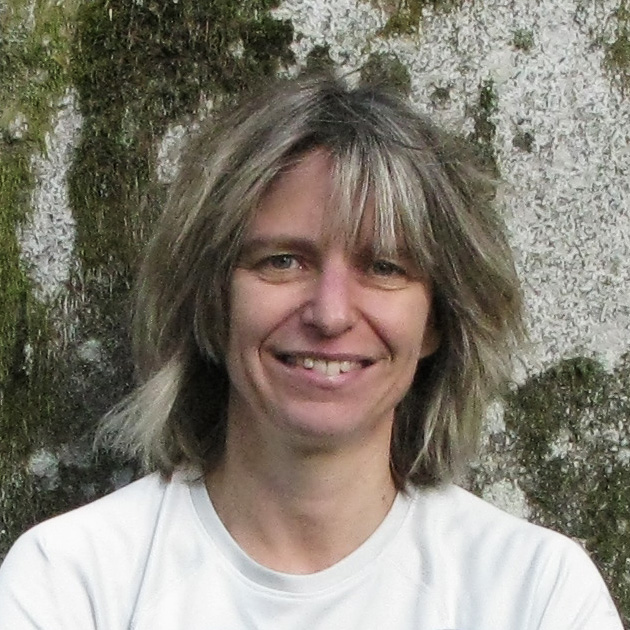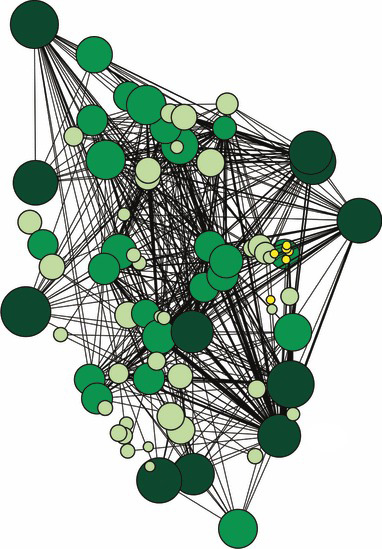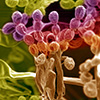Two decades ago, while researching her doctoral thesis, ecologist Suzanne Simard discovered that trees communicate their needs and send each other nutrients via a network of latticed fungi buried in the soil — in other words, she found, they “talk” to each other. Since then, Simard, now at the University of British Columbia, has pioneered further research into how trees converse, including how these fungal filigrees help trees send warning signals about environmental change, search for kin, and transfer their nutrients to neighboring plants before they die.

By using phrases like “forest wisdom” and “mother trees” when she speaks about this elaborate system, which she compares to neural networks in human brains, Simard’s work has helped change how scientists define interactions between plants. “A forest is a cooperative system,” she said in an interview with Yale Environment 360. “To me, using the language of ‘communication’ made more sense because we were looking at not just resource transfers, but things like defense signaling and kin recognition signaling. We as human beings can relate to this better. If we can relate to it, then we’re going to care about it more. If we care about it more, then we’re going to do a better job of stewarding our landscapes.”
Simard is now focused on understanding how these vital communication networks could be disrupted by environmental threats, such as climate change, pine beetle infestations, and logging. “These networks will go on,” she said. “Whether they’re beneficial to native plant species, or exotics, or invader weeds and so on, that remains to be seen.”
Yale Environment 360: Not all PhD theses are published in the journal Nature. But back in 1997, part of yours was. You used radioactive isotopes of carbon to determine that paper birch and Douglas fir trees were using an underground network to interact with each other. Tell me about these interactions.
Suzanne Simard: All trees all over the world, including paper birch and Douglas fir, form a symbiotic association with below-ground fungi. These are fungi that are beneficial to the plants and through this association, the fungus, which can’t photosynthesize of course, explores the soil. Basically, it sends mycelium, or threads, all through the soil, picks up nutrients and water, especially phosphorous and nitrogen, brings it back to the plant, and exchanges those nutrients and water for photosynthate [a sugar or other substance made by photosynthesis] from the plant. The plant is fixing carbon and then trading it for the nutrients that it needs for its metabolism. It works out for both of them.
It’s this network, sort of like a below-ground pipeline, that connects one tree root system to another tree root system, so that nutrients and carbon and water can exchange between the trees. In a natural forest of British Columbia, paper birch and Douglas fir grow together in early successional forest communities. They compete with each other, but our work shows that they also cooperate with each other by sending nutrients and carbon back and forth through their mycorrhizal networks.
e360: And they can tell when one needs some extra help versus the other, is that correct?
Simard: That’s right. We’ve done a bunch of experiments trying to figure out what drives the exchange. Keep in mind that it’s a back and forth exchange, so sometimes the birch will get more and sometimes the fir will get more. It depends on the ecological factors that are going on at the time.
One of the important things that we tested in that particular experiment was shading. The more Douglas fir became shaded in the summertime, the more excess carbon the birch had went to the fir. Then later in the fall, when the birch was losing its leaves and the fir had excess carbon because it was still photosynthesizing, the net transfer of this exchange went back to the birch.
There are also probably fungal factors involved. For example, fungus that is linking the network is going to be looking to secure its carbon sources. Even though we don’t understand a whole lot about that, it makes sense from an evolutionary point of view. The fungus is in it for its own livelihood, to make sure that it’s got a secure food base in the future, so it will help direct that carbon transfer to the different plants.
I don’t think there’s ever going to be a shortage of an ability to form a network, but the network might be different.
e360: Do you think this exchange system holds true in other ecosystems as well, like grasslands, for instance? Has there been any work done on that?
Simard: Yes, not just in my lab, but also in other labs well before me”¦ Grasslands, and even some of the tree species we’re familiar with like maple and cedar, form a different type of mycorrhiza. In British Columbia, we have big grasslands that come up through the interior of the province and interface with the forest. We’re looking at how those grasslands, which are primarily arbuscular mycorrhizal, interact with our ectomycorrhizal forest, because as climate changes, the grasslands are predicted to move up into the forests.
e360: Will these exchanges continue under climate change, or will communication be blocked?
Simard: I don’t think it will be blocked. I don’t think there’s ever going to be a shortage of an ability to form a network, but the network might be different. For example, there will probably be different fungi involved in it, but I think these networks will go on. Whether they’re beneficial to native plant species, or exotics, or invader weeds and so on, that remains to be seen.
e360: Through molecular tools, you and one of your graduate students discovered what you call hub, or mother, trees. What are they, and what’s their role in the forest?
Simard: Kevin Beiler, who was a PhD student, did really elegant work where he used DNA analysis to look at the short sequences of DNA in trees and fungal individuals in patches of Douglas fir forest. He was able to map the network of two related sister specials of mycorrhizal fungi and how they link Douglas fir trees in that forest.
Just by creating that map, he was able to show that all of the trees essentially, with a few isolated [exceptions], were linked together. He found that the biggest, oldest trees in the network were the most highly linked, whereas smaller trees were not linked to as many other trees. Big old trees have got bigger root systems and associate with bigger mycorrhizal networks. They’ve got more carbon that’s flowing into the network, they’ve got more root tips. So it makes sense that they would have more connections to other trees all around them.
In later experiments, we’ve been pursuing whether these older trees can recognize kin, whether the seedling that are regenerating around them are of the same kin, whether they’re offspring or not, and whether they can favor those seedlings — and we found that they can. That’s how we came up with the term “mother tree,” because they’re the biggest, oldest trees, and we know that they can nurture their own kin.

e360: You also discovered that when these trees are dying there’s a surprising ecological value to them that isn’t realized if they’re harvested too soon.
Simard: We did this experiment actually in the greenhouse. We grew seedlings of [Douglas fir] with neighbors [ponderosa pine], and we injured the one that would have been acting as the mother tree, [which was] the older fir seedling. We used ponderosa pine because it’s a lower elevation species that’s expected to start replacing Douglas fir as climate changes. I wanted to know whether or not there was any kind of transfer of the legacy of the old forest to the new forest that is going to be migrating upward and northward as climate changes.
When we injured these Douglas fir trees, we found that a couple things happened. One is that the Douglas fir dumped its carbon into the network and it was taken up by the ponderosa pine. Secondly, the defense enzymes of the Douglas fir and the ponderosa pine were “up-regulated” in response to this injury. We interpreted that to be defense signaling going on through the networks of trees. Those two responses — the carbon transfer and the defense signal — only happened where there was a mycorrhizal network intact. Where we severed the network, it didn’t happen.
The interpretation was that the native species being replaced by a new species as climate changes is sending carbon and warning signals to the neighboring seedlings to give them a head start as they assume the more dominant role in the ecosystem.
e360: You’ve talked about the fact that when you first published your work on tree interaction back in 1997 you weren’t supposed to use the word “communication” when it came to plants. Now you unabashedly use phrases like forest wisdom and mother trees. Have you gotten flack for that?
Simard: There’s probably a lot more flack out there than I even hear about. I first started doing forest research in my early 20s and now I’m in my mid-50s, so it has been 35 years. I have always been very aware of following the scientific method and of being very careful not to go beyond what the data says. But there comes a point when you realize that that sort of traditional scientific method only goes so far and there’s so much more going on in forests than we’re able to actually understand using the traditional scientific techniques.
So I opened my mind up and said we need to bring in human aspects to this so that we understand deeper, more viscerally, what’s going on in these living creatures, species that are not just these inanimate objects. We also started to understand that it’s not just resources moving between plants. It’s way more than that. A forest is a cooperative system, and if it were all about competition, then it would be a much simpler place. Why would a forest be so diverse? Why would it be so dynamic?
To me, using the language of communication made more sense because we were looking at not just resource transfers, but things like defense signaling and kin recognition signaling. The behavior of plants, the senders and the receivers, those behaviors are modified according to this communication or this movement of stuff between them.
Also, we as human beings can relate to this better. If we can relate to it, then we’re going to care about it more. If we care about it more, then we’re going to do a better job of stewarding our landscapes.
If we leave trees that support not just mycorrhizal networks, but other networks of creatures, then the forest will regenerate.
e360: The mountain pine beetle is devastating western [North American] landscapes, killing pine and spruce trees. You coauthored research on what pine beetle attacks do to mycorrhizal networks. What did you find, and what are the implications for regeneration of those forests?
Simard: That work was led by Greg Pec, a graduate student at the University of Alberta. The first stage (of the attack) is called green attack. They go from green attack to red attack to gray attack. So basically, by the third or fourth year, the stands are dead.
We took soil from those different stands and grew log pole pine seedlings in them. We found that as time went on with mortality, that mycorrhizal network became less diverse and it also changed the defense enzyme in the seedlings that were grown in those soils. The diversity of those molecules declined. The longer the trees had been dead, the lower the mycorrhizal diversity and the lower the defense molecule diversity was in those seedlings.
Greg, in looking at the fungal diversity in those stands, found that even though the fungal diversity changed, the mycorrhizal network was still important in helping regenerate the new seedlings that were coming up in the understory.
Even though the composition of that mycorrhizal network is shifting, it’s still a functional network that is able to facilitate regeneration of the new stand.
e360: What does your work tell you about how to maintain resilience in the forest when it comes to logging and climate change?
Simard: Resilience is really about the ability of ecosystems to recover their structures and functions within a range of possibilities. For forests in particular, trees are the foundation. They provide habitat for the other creatures, but also make the forest work. Resilience in a forest means the ability to regenerate trees. There’s a lot that can be done to facilitate that because of these mycorrhizal networks, which we know are important in allowing trees to regenerate. It’s what we leave behind that’s so important. If we leave trees that support not just mycorrhizal networks, but other networks of creatures, then the forest will regenerate. I think that’s the crucial step is maintaining that ability to regenerate trees.
e360: You’ve spoken about your hope that your findings would influence logging practices in British Columbia and beyond. Has that happened?
Simard: Not my work specifically. Beginning in the 1980s and 90s, that idea of retaining older trees and legacies in forests retook hold. Through the 1990s in Western Canada, we adopted a lot of those methodologies, not based on mycorrhizal networks. It was more for wildlife and retaining down wood for habitat for other creatures.
But for the most part, especially in the last decade and a half, a lot of [logging] defaults to clear-cutting with not that much retention. Part of that was driven by the mountain pine beetle outbreak that is still going on. The good forestry practices that were developing got swept away in the salvage logging of those dying trees.
ALSO FROM YALE e360Is Climate Change Putting World’s Microbiomes at Risk?

Today, people are still trying retention forestry, but it’s just not enough. Too often it’s just the token trees that are left behind. We’re starting on a new research project to test different kinds of retention that protect mother trees and networks.
e360: That’s the grant that you just received from the Canadian government to reassess current forest renewal practices?
Simard: Yes, we’re really excited about this. We’re testing the idea of retaining mother trees in different configurations — so leaving them as singles, as groups, as shelter woods, and then regenerating the forest using a mix of natural regeneration and traditional regeneration practices. We’re testing these across a range of climates in Douglas fir forest, from very dry and hot all the way up to cool and wet. There’s going to be about 75 sites in total that cross this climate gradient. We’re going to be measuring things like carbon cycling and productivity and bird and insect diversity. And we’ve got a lot of interest from First Nations groups in British Columbia because this idea of mother trees and the nurturing of new generations very much fits with First Nations’ world view.